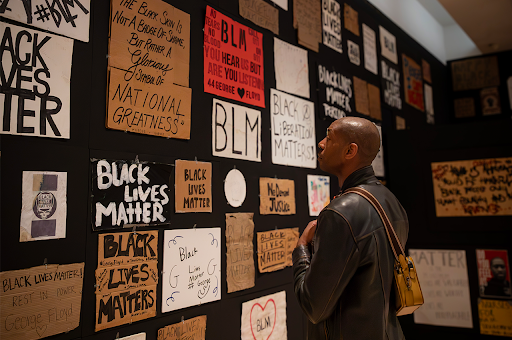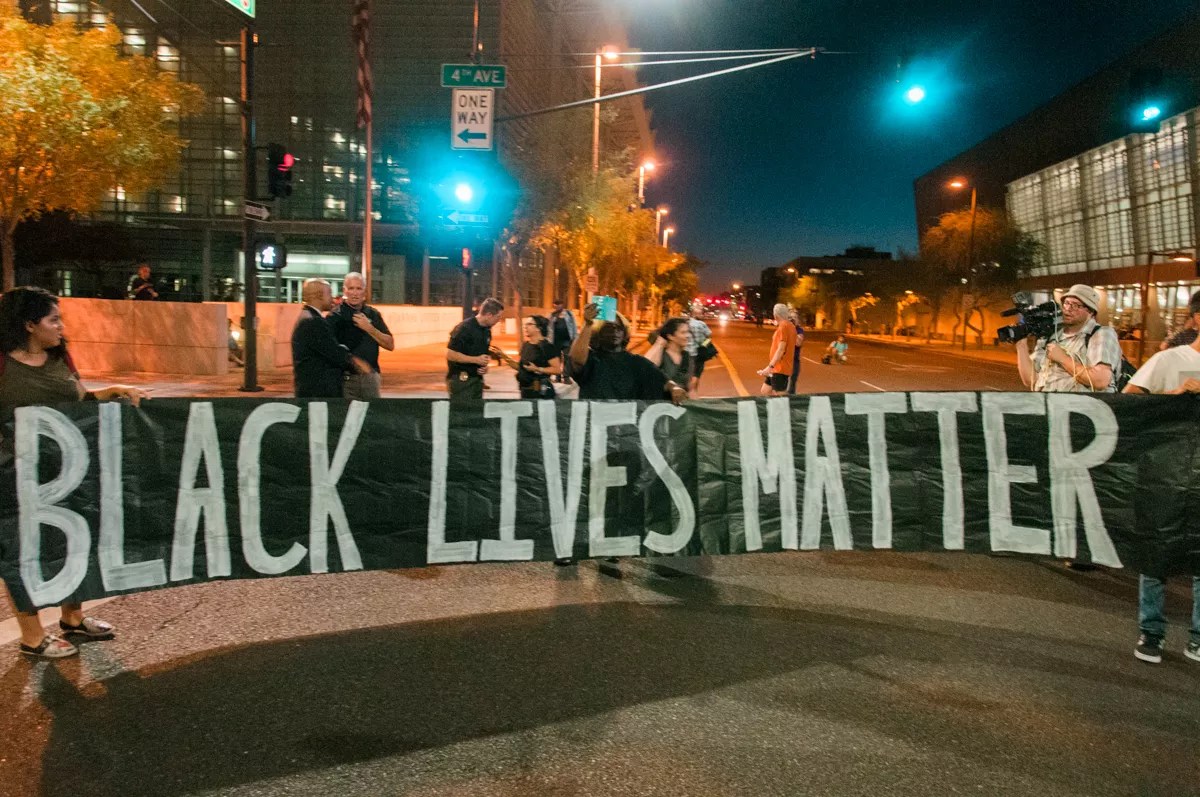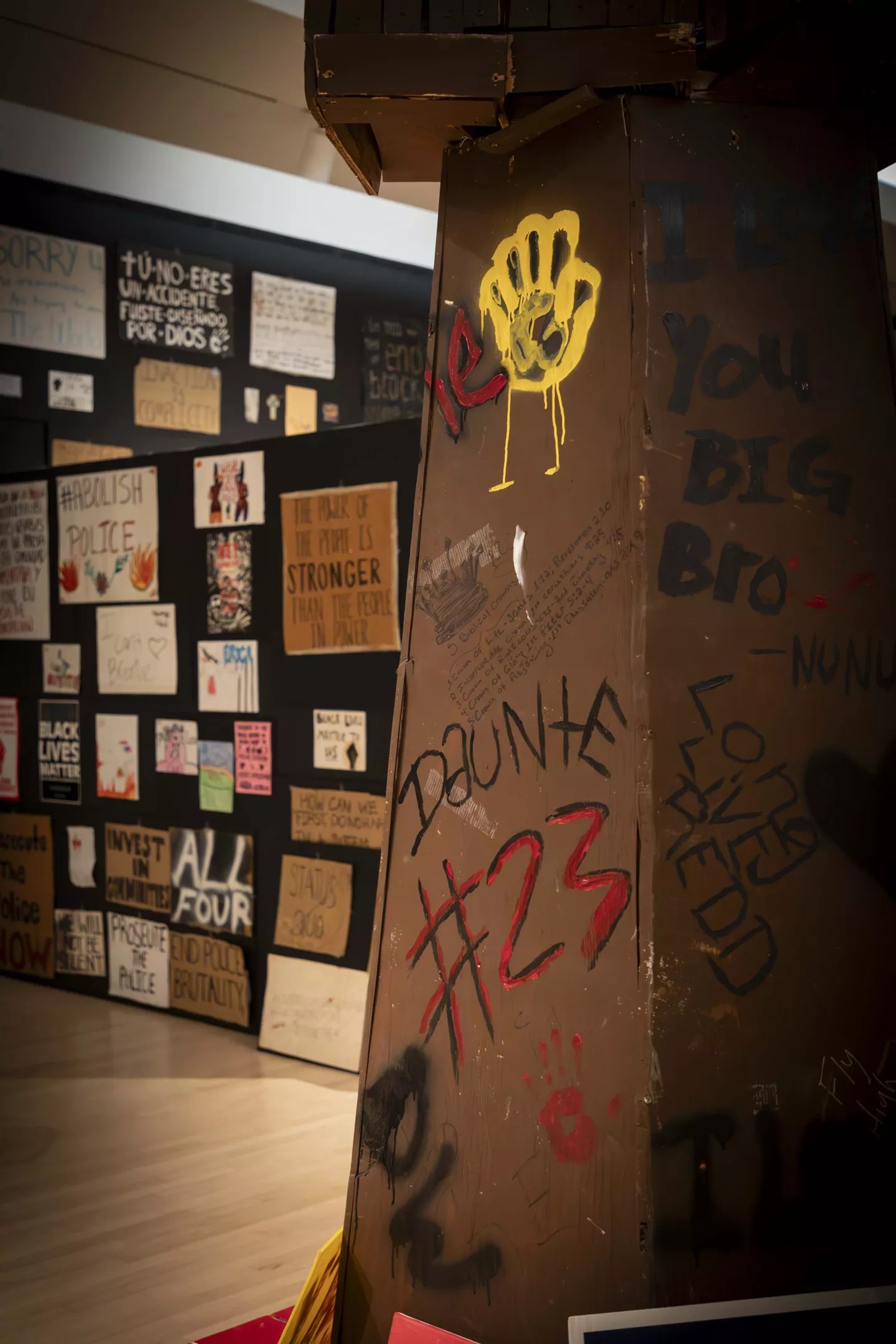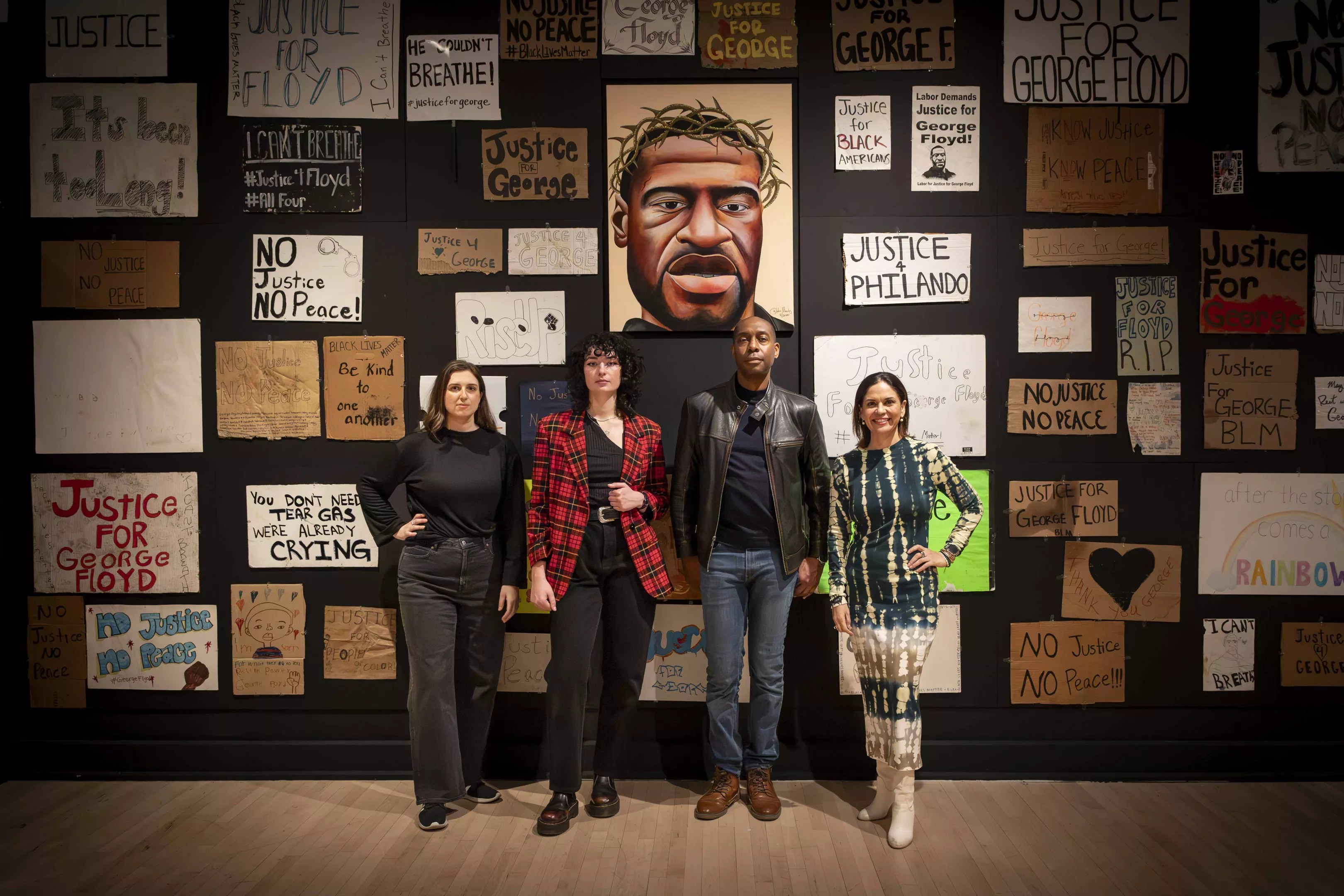
Mary Berkstresser

Audio By Carbonatix
In May 2020, amid a global pandemic, another world-changing event occurred.
The murder of George Floyd by Minneapolis police officers, one of whom knelt on his neck for more than 9 minutes until he died, was the impetus for worldwide protests against police brutality and racial injustice. In more than 2,000 cities and on seven continents, an outraged public held high signs reading “Black Lives Matter” and “No Justice, No Peace.”
In Minneapolis, a group of people, including Jeanelle Austin, began picking up and saving the signs, art and messages left in what would come to be known as George Floyd Square. Less than four years later, Austin is the executive director of the George Floyd Global Memorial, which she describes as a “nonprofit organization that exists to care for the stories of resistance to racial injustice and to curate spaces for people to grieve, pay respects and be a voice for racial justice.” The group has collected between 5,000 and 10,000 objects.
For the first time outside Minnesota, about 500 “offerings,” as they’re called, will go on display beginning Feb. 3 in “Twin Flames: The George Floyd Uprising from Minneapolis to Phoenix,” an exhibition at ASU Art Museum.
“It’s been a collaboration of everyday people, and that’s how it’s supposed to be, because these memorial offerings are a collection of the voices of the people and the exhibition is an extension of that. We’re sending 500 voices down to Phoenix,” Austin says.

Protesters unfurl a “Black Lives Matter” banner in Phoenix in 2020.
Ash Ponders
Why Phoenix?
As Dr. Rashad Shabazz, an associate professor in the schools of Social Transformation and Geographical Sciences & Urban Planning at ASU, tells it, he and Dr. Michael McQuarrie, the director of the university’s Center for Work and Democracy, were in Minneapolis in 2022 and attended an event called Rise & Remember on the anniversary of Floyd’s murder.
The George Floyd Global Memorial hosted the event, which included an auction of the right to display some of the memorial offerings outside of Minnesota. The Center for Work and Democracy won the auction.
Shabazz, who is a member of the Center for Work and Democracy, is also on the board of the ASU Art Museum, and asked museum director Miki Garcia if the pieces could be shown there.
“This museum’s vision is to center art and artists in the service of social good and community well-being. That’s our purpose,” Garcia says.
“If ASU’s charter is inclusivity and innovation, how do we think about that in the role of a university art museum? When we think about memorials out in the landscape, they are commissioned, they are artists, they are civic. But this is a people’s memorial, and this has a right to be acknowledged and honored just like all the memorials that are out in the public landscape. It felt for us like a really good proposal and idea to be in a museum,” she adds.
Austin says it was important for the pieces to be seen outside Minneapolis, and the exhibit “ties the protests and the injustices together in a way that as activists we have already tied together and are supporting each other across the country. We are taking the voices of protest from the memorial and lending them to amplify the stories and the voices in Phoenix.”
Shabazz says there are parallels between the ongoing problem of police brutality both in Minneapolis and Phoenix, and indeed, one of the first things the viewer sees in the exhibition is a list of some of the people who have been killed by Phoenix Police Department officers.
“We think it’s also important to have it at a place like Arizona because Arizona and the Phoenix metropolitan area has a long history of racism, of anti-Black violence and police violence against Black and brown and Indigenous people and people with serious mental illnesses,” he says. “Our police department is currently under investigation with the Justice Department. We have a history of this here, and we hope this fosters a dialogue.”

The exhibition space at ASU Art Museum contains about 500 signs.
Mary Berkstresser
The exhibit
“Twin Flames” is certain to foster dialogue, along with anger and tears. Set up in one large room on the second floor of the museum, about 500 signs are organized according to themes: Say Their Names, Justice?, Black Lives Matter, Community Brings Safety, and Solidarity.
“They were left by the local community in Minneapolis, people throughout the state, throughout the nation and the world, to share their pain, their sorrow, their frustrations, their anger, their hope, their solidarity and their desire for possibility, and these signs are a collage of that,” Shabazz says.
“They speak toward solidarity, they speak toward accountability, they speak toward hope and possibility, they speak toward acknowledging that Black lives are valuable and that they matter, they speak toward remembering our past, and they also speak toward the possibilities for a different future,” he adds.
Out of the thousands of options, the pieces in “Twin Flames” were chosen by a Community of Practice that included Black Phoenix residents as young as 9 years old.
The signs are big and small, square and round and heart-shaped. Some are written in Spanish. They’re scribbled on notebook paper, written in marker on bright poster board, angrily scrawled on the walls of cardboard boxes, painstakingly printed by small children who misspell “racism” and write their Ks backward. (All the signs in the exhibit that were made by children are placed lower on the wall so other children can see them better.)
They read: “My Black Family Matters.” “Justice for George.” “You Don’t Need Tear Gas – We’re Already Crying.” “Am I Next?” “How Many Weren’t Filmed?” “Prosecute the Police.” “Nurses for Fair Treatment.” “Your Life Mattered, Mr. Floyd.” “No Justice, No Peace.” “My Blackness Is Not a Threat.” “Trans Black Lives Matter.” “The Power of the People Is Stronger Than the People in Power.” “Color Is Not a Crime.”
For Brittany Corrales, a curator at ASU Art Museum who helped facilitate and organize the exhibition, viewing the offerings in person when they arrived earlier this month was overwhelming.
“It’s one thing to talk about it and see photos of it and see it on a screen as the community was selecting everything, but to see it all assembled at once, it’s incredibly emotional,” she says. “The offerings are really extensions of the people who made them, and they carry all the emotions and the feelings and the hopes and prayers of those people who made them at the time.”
The museum will also host a public ofrenda – an altar to honor lost loved ones – and offer visitors to the museum art supplies to create their own offerings.
A number of related programs and events are scheduled throughout the exhibit’s run, which ends on July 28.
The exhibit opens on Feb. 2 with a reception from 5 to 7 p.m. Austin will be on hand to give a guided walkthrough of the space, and attendees can also enjoy a food truck, bar, arts activities and musical entertainment curated by DJ CRVANT3S. From 8 p.m. to midnight, guests can take part in a silent disco as part of the A Taste of Melanin event series.
A selection of the planned programming includes a March 28 lecture on “Histories of Protest in Art and Music”; an April 6 screening of the film “Stonebreakers” with a panel discussion to follow; and a May 2 discussion titled “Are Objects Forever? The Evolving Thinking on Conservation and Collections Care.” More events will be announced in the months to come.
This is the sixth time the offerings have been publicly shown, but the first in a museum. In Minneapolis, the pieces have been on display in places like a hospital and the lobby of a performance venue.
Garcia speaks to the importance of putting these objects in a museum setting.
“My own personal relationship to museums is that my father was involved in the Chicano civil rights movement. He was an artist, and it was through the civil rights movement and his ability to make posters and signs and murals that he was able to transcend the limits that had been set on him,” she says.
“I think about people coming in here and seeing their own stories, their own struggles, their own frustrations, their own hopes being reflected on the walls of a museum and how that could be an entryway for them to be more of themselves and go out and help shape the community we want to live in,” Garcia adds.

Pictured, from left, are Brittany Corales, Maria Esch, Dr. Rashad Shabazz and Miki Garcia. Corales is a curator at the ASU Art Museum, Esch is a researcher at ASU’s Center for Work and Democracy, Shabazz is an ASU professor and Garcia is the director of the ASU Art Museum.
Mary Berkstresser
‘Be in the room, experience the pain’
Just as every viewer brings their own lived experience and unique perspective to, say, a Monet painting or a Botero sculpture, the offerings in “Twin Flames” will mean different things to different people.
But differences don’t need to separate us, and Shabazz hopes that the exhibit will be a turning point to unite those who see it.
“We wanted to use (“Twin Flames”) as a way to bring people together, to allow for people who have been subject to police violence or police harassment to have a space to have this experience, and for those who don’t believe that it exists to come here and witness it. And for those who are even in opposition that such an exhibit should exist, for them to come here and witness it and see,” he says.
“So really this is a space for openness where we want to foster exchange, we want to foster community and we want to foster dialogue,” Shabazz adds.
To Shabazz, that means getting involved. One way the public can do that is by donating to the exhibit’s PitchFunder campaign. (PitchFunder is Arizona State University’s official crowdfunding platform.)
“This is a community-led and -organized exhibition and we want the community to participate in helping to raise money to sustain it,” he says.
At the exhibition, QR codes around the room lead to the Black Lives Matter Phoenix Metro website, where people can learn how to get involved locally in issues such as anti-racism and social justice.
But mostly, Shabazz wants the public to see the show.
“You can’t be involved in transformation if you just sit in your house and you whittle away something on a tweet,” he says. “You have to come and see it and be in the room, experience the pain and the suffering, the anger, the frustration, the possibility, the hope and the joy that’s put on all these signs.”
The signs keep coming, by the way. In Minneapolis, visitors from around the world continue to leave offerings in George Floyd Square, and members of the George Floyd Global Memorial pick them up and preserve them. Because four years after Floyd’s death, people of color continue to be murdered by police across the country.
“We’re still facing these challenges nationwide, and our exhibit inspires people to keep working, to keep going,” Austin says. “Don’t think that just because the media cycle is quiet that the people are silent, because the people have spoken and they continue to speak through the offerings that they have laid.”

Images of George Floyd can be found around the exhibition.
Mary Berkstresser
‘Historic and transformative’
A room full of cardboard signs made by ordinary citizens is not an expected sight in an art museum.
And that, Shabazz says, is a large part of what makes “Twin Flames” so important.
“This is historic,” he says. “Nothing like this has ever been done before. Nothing like this has been done at the museum. These offerings have never been shown outside of Minneapolis, the collaboration between various groups here at ASU and the George Floyd Global Memorial has never been done. And we recognize that not only have these groups never been brought together, but never has public memorialization ever been placed in this museum and in most museums across the country.
“I am beyond proud to be a part of something this historic and transformative. This is one of the greatest things I’ve ever been a part of in my life. And for it to be here in Phoenix, I think it matters so much.”
“Twin Flames: The George Floyd Uprising from Minneapolis to Phoenix” runs Feb. 3 to July 28 at ASU Art Museum, 51 E. 10th St., Tempe. Hours are 11 a.m. to 5 p.m. Wednesday through Sunday. Admission is free. The opening reception begins at 5 p.m. on Feb. 2. Visit the ASU Art Museum website for more information.